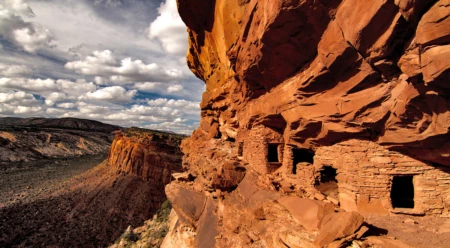Hey, How’s That Lawsuit Against the President Going?
Glad you asked … and if you aren’t already aware, in December 2017, President Trump issued a proclamation slashing Utah’s Bears Ears National Monument by 85 percent and Grand Staircase-Escalante National Monument, 100 miles to the west of Bears Ears, by half. In an unprecedented response, we joined a coalition of Native American and grassroots groups challenging the legality of the president’s action in the US District Court for the District of Columbia. The legal theory is simple: The Antiquities Act of 1906 grants the president the authority to create national monuments, but not to reduce or rescind them.
There are five pending lawsuits—two for Grand Staircase and three for Bears Ears. The district court has consolidated each set of cases—the Grand Staircase suits on one hand, the Bears Ears suits on the other—for administrative purposes so that the cases within each consolidated set proceed on the same schedule.
In January 2018, the Trump administration tried to move the case from DC to Utah (the court refused), and in October, the government filed a motion to dismiss the complaint altogether. Each side has since submitted briefs. Right now, we’re awaiting a decision on whether the case will proceed from Judge Tanya S. Chutkan. That’s expected in mid-to-late 2019.
We are proud to join several Native American Tribes (Hopi, Navajo Nation, Ute, Ute Mountain Ute, and Zuni) and conservation nonprofits in the Bears Ears litigation, including our co-plaintiffs: Utah Diné Bikéyah, Friends of Cedar Mesa, Conservation Lands Foundation, Archaeology Southwest, National Trust for Historic Preservation, Society of Vertebrate Paleontology and Access Fund. These two national monuments were designated to protect a multitude of sites of cultural significance to Native Americans. The facts aren’t in dispute; all five cases come down to what the Antiquities Act does—or doesn’t—say.
“There continues to be a lot of misinformation about Native communities, and negative stereotypes, in the state of Utah, and these prevent the tribes from having equal rights and being treated as equal citizens,” says Honor Keeler, the assistant director of Utah Diné Bikéyah, who is working on the case. Establishing these monuments was part of a healing process, Keeler, a citizen of the Cherokee Nation, says, and “an acknowledgement that Indigenous Peoples have a right to determine the future of their sacred and traditional homelands.”
“I’ve been very encouraged by how well all the plaintiff attorneys are working in unison on these cases,” says Natalie Landreth, a senior staff attorney for the Native American Rights Fund, which is representing the tribes in their lawsuit. Landreth is a citizen of the Chickasaw Nation, and is based in Anchorage, Alaska. “Simply given the sheer number of people involved—something like 20 lawyers—it gives you pause. The collaboration has been much easier than expected, and it has really benefitted the case.”
The political landscape surrounding Bears Ears, meanwhile, has changed considerably. In the past, Utah’s San Juan County Commission had opposed the designation of Bears Ears as a national monument. With the election in November 2018 of Willie Grayeyes, a Diné (Navajo) leader, the commission has since condemned the president’s move to slash the monument. Reflecting the wishes of a majority of local communities, the commission has gone further, passing a resolution supporting the monument’s restitution. In Congress, Arizona representative Ruben Gallego and New Mexico rep Deb Haaland introduced the Bears Ears Expansion And Respect for Sovereignty Act (BEARS Act), which would bring the monument to the size originally petitioned for—600,000 acres larger, in fact, than the boundaries then-President Obama designated in 2016.
“While we’re waiting to see how the litigation plays out, the federal government—the Bureau of Land Management and Forest Service—have been expediting the planning process for an Environmental Impact Statement for the Shash Jaa’ and Indian Creek units,” Keeler points out. “These two units comprise only 15% of the original Bears Ears National Monument boundary. We are concerned that the proper cultural surveys and environmental studies have not been done. To fully understand how to protect Bears Ears, meaningful consultations with tribes are necessary, which are part of the government-to-government relationship tribes have with the federal government. Tribes have maintained Bears Ears since time immemorial.”
“While legally the tribes and NGOs are making the same case—that the president does not have the authority to reduce these monuments—the tribes have consistently asked for separate briefings to address their unique cultural concerns,” says Landreth. “While the public lands in a monument belong to everyone, the tribal interest in these areas is different from recreating in them. To the tribes, Bears Ears is very much alive. They have ancestors buried there, and still consider it part of their home to this day. This is a place where there are structures and human history that’s older than the Egyptian pyramids: the very kind of place the Antiquities Act was meant to protect. If there are to be arguments in front of the judge—and I hope there will be—that will be a place where these stories come alive.”
For Patagonia, joining the legal fracas was both extraordinary and obvious. For more than a decade the company has worked side by side with the tribes, climbers, canyoneers, trail runners and anglers to protect these public lands, so when Trump tried to offer them up to oil, gas and mining interests instead, the decision to sue came quickly.
“It took exactly one email to the board,” says Patagonia General Counsel Hilary Dessouky. “And the response was instant: ‘Yes. Absolutely. Go for it.’”
Learn more about why Patagonia is in the fight for Bears Ears at Patagonia Action Works.

